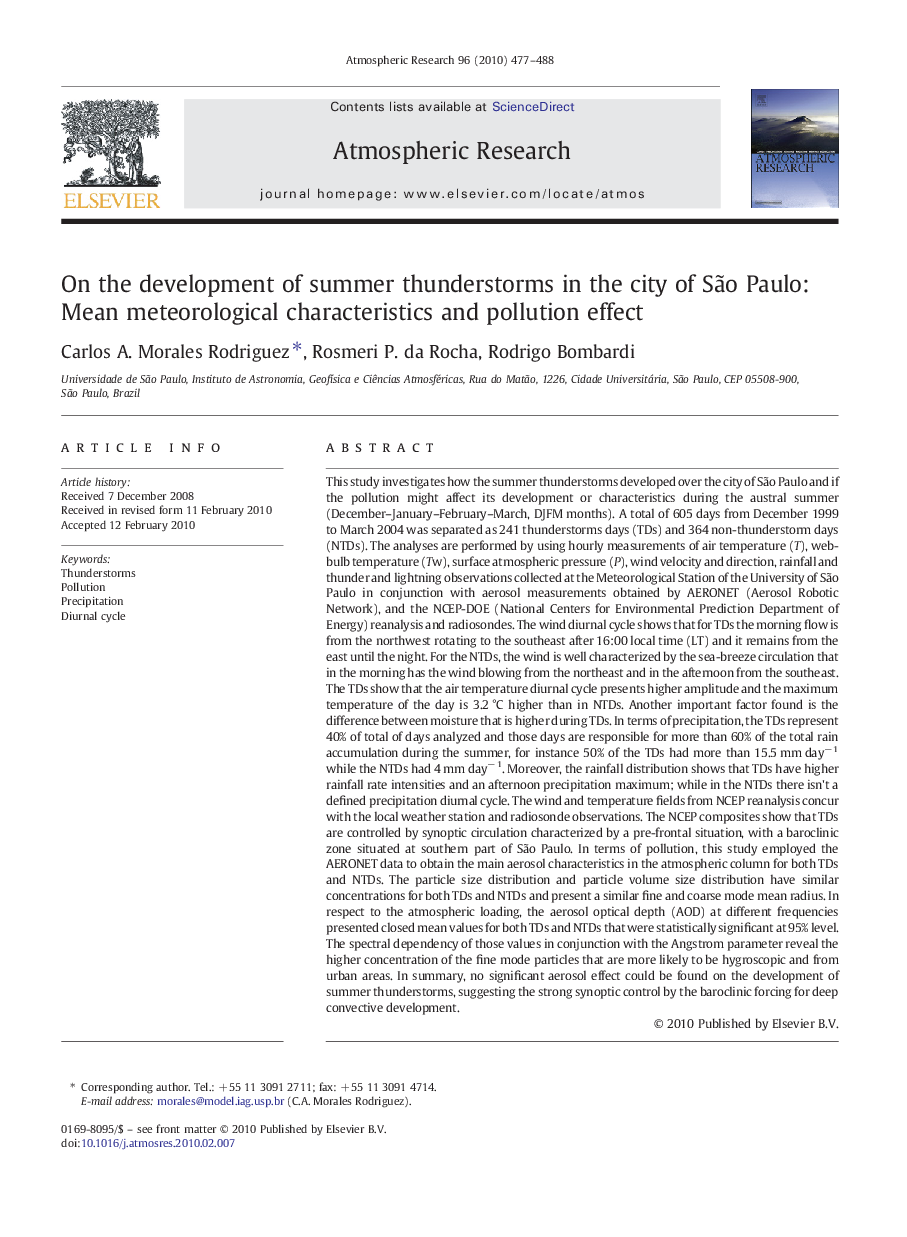| کد مقاله | کد نشریه | سال انتشار | مقاله انگلیسی | نسخه تمام متن |
|---|---|---|---|---|
| 4450693 | 1620567 | 2010 | 12 صفحه PDF | دانلود رایگان |
عنوان انگلیسی مقاله ISI
On the development of summer thunderstorms in the city of São Paulo: Mean meteorological characteristics and pollution effect
دانلود مقاله + سفارش ترجمه
دانلود مقاله ISI انگلیسی
رایگان برای ایرانیان
کلمات کلیدی
موضوعات مرتبط
مهندسی و علوم پایه
علوم زمین و سیارات
علم هواشناسی
پیش نمایش صفحه اول مقاله

چکیده انگلیسی
This study investigates how the summer thunderstorms developed over the city of São Paulo and if the pollution might affect its development or characteristics during the austral summer (December-January-February-March, DJFM months). A total of 605 days from December 1999 to March 2004 was separated as 241 thunderstorms days (TDs) and 364 non-thunderstorm days (NTDs). The analyses are performed by using hourly measurements of air temperature (T), web-bulb temperature (Tw), surface atmospheric pressure (P), wind velocity and direction, rainfall and thunder and lightning observations collected at the Meteorological Station of the University of São Paulo in conjunction with aerosol measurements obtained by AERONET (Aerosol Robotic Network), and the NCEP-DOE (National Centers for Environmental Prediction Department of Energy) reanalysis and radiosondes. The wind diurnal cycle shows that for TDs the morning flow is from the northwest rotating to the southeast after 16:00 local time (LT) and it remains from the east until the night. For the NTDs, the wind is well characterized by the sea-breeze circulation that in the morning has the wind blowing from the northeast and in the afternoon from the southeast. The TDs show that the air temperature diurnal cycle presents higher amplitude and the maximum temperature of the day is 3.2 °C higher than in NTDs. Another important factor found is the difference between moisture that is higher during TDs. In terms of precipitation, the TDs represent 40% of total of days analyzed and those days are responsible for more than 60% of the total rain accumulation during the summer, for instance 50% of the TDs had more than 15.5 mm dayâ 1 while the NTDs had 4 mm dayâ 1. Moreover, the rainfall distribution shows that TDs have higher rainfall rate intensities and an afternoon precipitation maximum; while in the NTDs there isn't a defined precipitation diurnal cycle. The wind and temperature fields from NCEP reanalysis concur with the local weather station and radiosonde observations. The NCEP composites show that TDs are controlled by synoptic circulation characterized by a pre-frontal situation, with a baroclinic zone situated at southern part of São Paulo. In terms of pollution, this study employed the AERONET data to obtain the main aerosol characteristics in the atmospheric column for both TDs and NTDs. The particle size distribution and particle volume size distribution have similar concentrations for both TDs and NTDs and present a similar fine and coarse mode mean radius. In respect to the atmospheric loading, the aerosol optical depth (AOD) at different frequencies presented closed mean values for both TDs and NTDs that were statistically significant at 95% level. The spectral dependency of those values in conjunction with the Angstrom parameter reveal the higher concentration of the fine mode particles that are more likely to be hygroscopic and from urban areas. In summary, no significant aerosol effect could be found on the development of summer thunderstorms, suggesting the strong synoptic control by the baroclinic forcing for deep convective development.
ناشر
Database: Elsevier - ScienceDirect (ساینس دایرکت)
Journal: Atmospheric Research - Volume 96, Issues 2â3, May 2010, Pages 477-488
Journal: Atmospheric Research - Volume 96, Issues 2â3, May 2010, Pages 477-488
نویسندگان
Carlos A. Morales Rodriguez, Rosmeri P. da Rocha, Rodrigo Bombardi,